

40 Cool and Awesome Inventions (2020) Inventions, mostly, change the world for good by filling up gaps between our expectations and the available products.
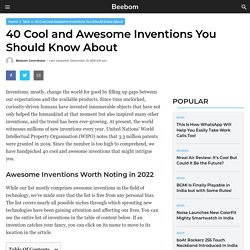
Since time unclocked, curiosity-driven and purposeful humans have invented innumerable objects that have not only helped the humankind at that moment but also inspired many other inventions, and the trend has been ever-growing. At present, the world witnesses millions of new inventions every day. United Nations’ World Intellectual Property Organisation (WIPO) notes that 3.3 million patents were granted in 2018 and pragmatically, the number of inventors either awaiting a patent or having omitted the process altogether is expected to be much larger. The 20 Coolest Inventions of 2016. The 50 Best Inventions of 2018.
Patents: Property or Monopoly? - Patent Progress. Patents are often described either as property or a monopoly — both are only partially correct and potentially misleading.
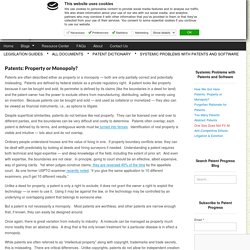
Patents are defined by federal statute as a private regulatory right. A patent looks like property because it can be bought and sold, its perimeter is defined by its claims (like the boundaries in a deed for land) and the patent owner has the power to exclude others from manufacturing, distributing, selling or merely using an invention. Because patents can be bought and sold — and used as collateral or monetized — they also can be viewed as financial instruments, i.e., as options to litigate. The 10 most intriguing inventions of 2018. We are all about emerging technologies here at Tech Review—including those that might never make it past the “emerging” stage.
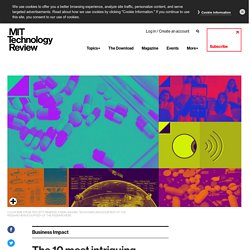
Here are some of the more recondite inventions we have covered this year, many of them plumbed from the arXiv, the pre-publication academic paper database. Artificial synapses An electronic synapse that fires millions of times faster than the ones in your brain could be used to build artificial neural networks. Anti-aging medicines A clinical trial of drugs called mTOR inhibitors found that they boosted elderly people’s immune systems, potentially extending their life spans. Electric planes with no moving parts Instead of propellers, this aircraft uses electroaerodynamic propulsion. DNA computing for programmable pills. 10 Breakthrough Technologies 2013. Consent Form. In June, the U.S.
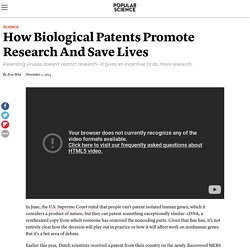
Supreme Court ruled that people can't patent isolated human genes, which it considers a product of nature, but they can patent something exceptionally similar: cDNA, a synthesized copy from which someone has removed the noncoding parts. Given that fine line, it's not entirely clear how the decision will play out in practice or how it will affect work on nonhuman genes.
But it's a hot area of debate. Earlier this year, Dutch scientists received a patent from their country on the newly discovered MERS virus that killed at least 30 people. The researchers had isolated the virus in their laboratory from a sample sent by a Saudi doctor. A patent creates a financial incentive for innovation and discovery. Patents also force people to share information about innovations and their commercial potential. A patent creates a financial incentive for innovation and discovery.Biological patents have already been saving lives for some time. A 1980 U.S. Boston University Sues Apple For Alleged Patent Infringement. Boston University wants Apple to stop selling iPhones to its students, and everyone else for that matter, alleging that the company is stealing a two-decade-old idea from one of the school’s professors.

A complaint filed by the university’s trustees Tuesday in the U.S. District Court of Massachusetts claims a component in Apple’s iPhone 5, iPads and MacBook Air rips off a patent filed by a BU professor in the 1990s, the Boston Herald reports. The lawsuit requests that Apple halt its sale of those products, due to the allegedly violating the patent rights.
Gigaom explains where Apple allegedly ripped off a professor’s idea: The trustees of BU say the Apple products contain a “gallium nitride thin film semiconductor device” that is still under patent protection. The university declined to comment to The Huffington Post, saying through a spokesman “the complaint speaks for itself.” Read the complaint filed by Boston University against Apple, Inc. Subject matter in Canadian patent law. We ask you, humbly, to help.
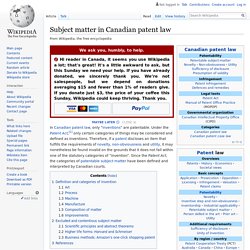
Hi reader in Canada, it seems you use Wikipedia a lot; that's great! It's a little awkward to ask, but this Sunday we need your help. If you have already donated, we sincerely thank you. We’re not salespeople, but we depend on donations averaging $15 and fewer than 1% of readers give. If you donate just $3, the price of your coffee this Sunday, Wikipedia could keep thriving. Maybe later Thank you! Close Definition and categories of invention[edit] Section 2 of the Patent Act defines “invention” as: [A]ny new and useful art, process, machine, manufacture or composition of matter, or any new and useful improvement in any art, process, machine, manufacture or composition of matter.[2] Each of the five categories of inventions has been further defined by the Canadian Intellectual Property Office and the Canadian courts.
Art[edit] Shell Oil Co. v. Process[edit] In Tennessee Eastman Co. v. Machine[edit] Manufacture[edit] Composition of matter[edit]